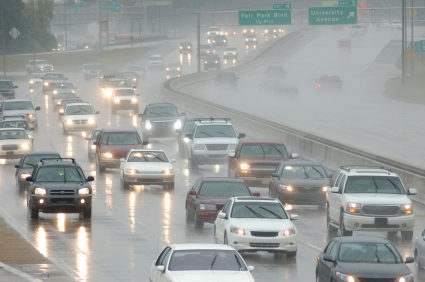Rachel Hartman
It may seem like just a drizzle, but the risks of driving in rain can be fatal.
On average, more than 7,100 people die in weather-related car crashes each year, according to the Federal Highway Administration (FHWA). In addition, car crashes involving weather result in 629,000 injuries every year.
And a crash could hike up your auto insurance premium. Crash statistics, including weather-related crashes, are taken into account when setting auto insurance premiums. Other factors, including driving records and the number of miles driven in a year, also play a role in the final price.
Working to improve road safety
Recent advancements in technology aim to help drivers be more aware of road conditions, especially during bad weather. One of these, known as the DSC111 Remote Surface State Sensor, uses laser technology to view road surfaces. The instrument is set up along the side of the road, where it measures road conditions. It can determine if there is water, ice, slush, snow or frost on the pavement. It sends this information to maintenance and traffic managers.
“Maintenance and traffic managers can then notify drivers of adverse conditions down the road, as well as adjust their operations accordingly,” says Kevin Petty, chief science officer at Vaisala, a global company that manufactures the DSC111.
For instance, based on the road condition information they receive, traffic managers might change a message on an electronic road sign to say “Wet pavement ahead, slow down.”
Further advancements to improve road safety are underway. One of these is the Vehicle Data Translator, a system being designed to let drivers know up-to-the-minute information regarding road and weather conditions. The project is funded by the U.S. Department of Transportation.
The Vehicle Data Translator is being developed to collect information from cars, such as the air temperature reading and when windshield wipers are being used. To gather information, the Vehicle Data Translator is set up to use wireless technology and transfer the data from the vehicle to a main server. There the data from the car is combined with other weather information. Based on the findings, alerts might be sent to drivers to notify them of upcoming weather conditions.
For instance, drivers might receive a message that says, “Cars five miles ahead are reporting icy conditions.” As of now, the method of sending this notification hasn’t been determined, although systems such as OnStar and cellphones are being considered. And eventually, Drobot says, cars may be manufactured with the needed technology already built in the vehicle.
In theory, any vehicle from 1996 or after should be able to send information to the Vehicle Data Translator, says Sheldon Drobot, lead investigator of the research project. The newer the vehicle, the more information it is likely to have, since newer cars are more advanced than older vehicles.
However, it will be a while before the Vehicle Data Translator will become a regular feature in cars; a version is scheduled to be tested in three states next winter.
4 tips to prevent car crashes in bad weather
Here are four ways to stay safe when driving in poor weather conditions:
1. Be prepared for rain.
When driving in rain, first and foremost, slow down, says Bob Medved, safety expert for State Farm. In addition, make sure your car has tires in good condition. “The tire tread is designed to push water away from the tire,” Medved says. If your tires are bald, they won’t be able to push the water away and you could hydroplane.
If you’re driving through an area that doesn’t get a lot of rain, be wary when a downpour hits. As the rain hits the pavement, it will mix with oil and other buildup on the road, creating slick conditions.
2. Pay attention to fog.
Fog can reduce visibility to just a quarter of a mile or less, creating hazardous driving conditions, notes Weather.com.
When driving in fog, reduce your speed and turn your lights on low beam. Avoid high beam lights, as these will reflect back off the fog and could make it even harder to see. Then, open your window slightly to listen for traffic you may not be able to see.
3. Understand the dangers of high wind.
If you’re driving in an area prone to high winds, give yourself extra travel time, as you may need to drive slower than normal, advises the Nevada Department of Transportation.
When traveling through an area with high winds, pay attention to other vehicles on the road. Campers, RVs, trucks and buses are more susceptible to changes in the wind. During a sudden gust of wind, these vehicles could swing out and hit your car. Also, keep an eye out for objects that could blow on to the road, such as broken tree branches.
4. Bring emergency gear.
Just 9 percent of drivers have all of the essential safety items needed for an emergency in their car, according to a recent State Farm survey. The essential safety items listed in the survey were a spare tire, jumper cables, a hazard triangle or road flares, water, a first aid kid, blanket and flashlight.
In addition to keeping these items in your car, consider bringing additional emergency supplies. Keep a cellphone charger in your car, as well as warm clothing and non-perishable food, such as a protein bar.
